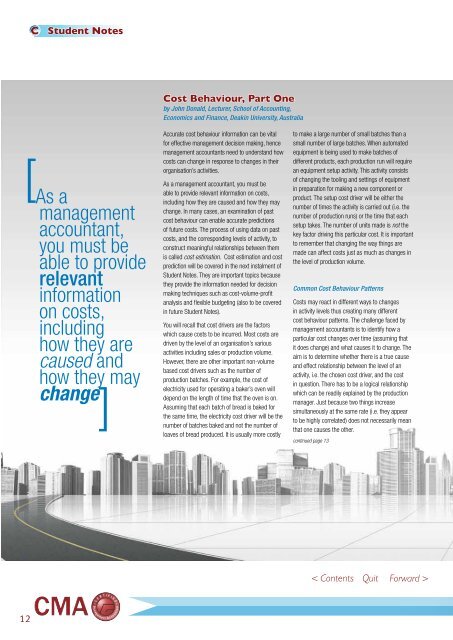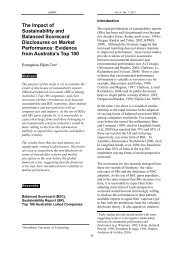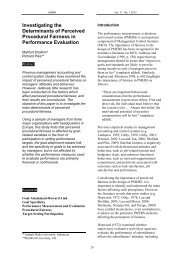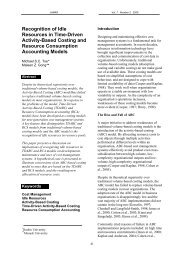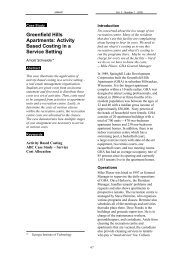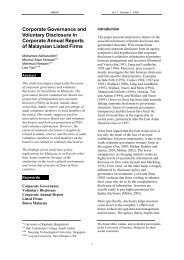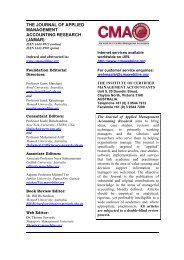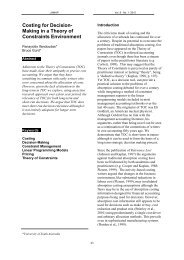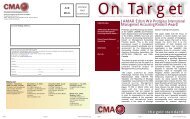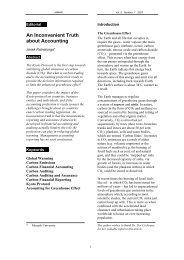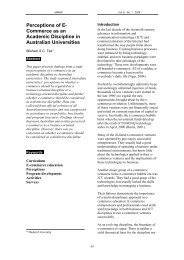Cost Behaviour - CMA - Certified Management Accountants
Cost Behaviour - CMA - Certified Management Accountants
Cost Behaviour - CMA - Certified Management Accountants
Create successful ePaper yourself
Turn your PDF publications into a flip-book with our unique Google optimized e-Paper software.
C<br />
Student Notes<br />
<strong>Cost</strong> <strong>Behaviour</strong>, Part One<br />
by John Donald, Lecturer, School of Accounting,<br />
Economics and Finance, Deakin University, Australia<br />
[ As a<br />
management<br />
accountant,<br />
you must be<br />
able to provide<br />
relevant<br />
information<br />
on costs,<br />
including<br />
how they are<br />
caused and<br />
how they may<br />
change<br />
]<br />
Accurate cost behaviour information can be vital<br />
for effective management decision making, hence<br />
management accountants need to understand how<br />
costs can change in response to changes in their<br />
organisation’s activities.<br />
As a management accountant, you must be<br />
able to provide relevant information on costs,<br />
including how they are caused and how they may<br />
change. In many cases, an examination of past<br />
cost behaviour can enable accurate predictions<br />
of future costs. The process of using data on past<br />
costs, and the corresponding levels of activity, to<br />
construct meaningful relationships between them<br />
is called cost estimation. <strong>Cost</strong> estimation and cost<br />
prediction will be covered in the next instalment of<br />
Student Notes. They are important topics because<br />
they provide the information needed for decision<br />
making techniques such as cost-volume-profit<br />
analysis and flexible budgeting (also to be covered<br />
in future Student Notes).<br />
You will recall that cost drivers are the factors<br />
which cause costs to be incurred. Most costs are<br />
driven by the level of an organisation’s various<br />
activities including sales or production volume.<br />
However, there are other important non-volume<br />
based cost drivers such as the number of<br />
production batches. For example, the cost of<br />
electricity used for operating a baker’s oven will<br />
depend on the length of time that the oven is on.<br />
Assuming that each batch of bread is baked for<br />
the same time, the electricity cost driver will be the<br />
number of batches baked and not the number of<br />
loaves of bread produced. It is usually more costly<br />
to make a large number of small batches than a<br />
small number of large batches. When automated<br />
equipment is being used to make batches of<br />
different products, each production run will require<br />
an equipment setup activity. This activity consists<br />
of changing the tooling and settings of equipment<br />
in preparation for making a new component or<br />
product. The setup cost driver will be either the<br />
number of times the activity is carried out (i.e. the<br />
number of production runs) or the time that each<br />
setup takes. The number of units made is not the<br />
key factor driving this particular cost. It is important<br />
to remember that changing the way things are<br />
made can affect costs just as much as changes in<br />
the level of production volume.<br />
Common <strong>Cost</strong> <strong>Behaviour</strong> Patterns<br />
<strong>Cost</strong>s may react in different ways to changes<br />
in activity levels thus creating many different<br />
cost behaviour patterns. The challenge faced by<br />
management accountants is to identify how a<br />
particular cost changes over time (assuming that<br />
it does change) and what causes it to change. The<br />
aim is to determine whether there is a true cause<br />
and effect relationship between the level of an<br />
activity, i.e. the chosen cost driver, and the cost<br />
in question. There has to be a logical relationship<br />
which can be readily explained by the production<br />
manager. Just because two things increase<br />
simultaneously at the same rate (i.e. they appear<br />
to be highly correlated) does not necessarily mean<br />
that one causes the other.<br />
continued page 13<br />
12
N TARGET<br />
Most costs are assumed to behave in a linear<br />
(straight line) manner but there are some costs<br />
which behave in a curvilinear manner or which<br />
increase in a series of steps. The assumption<br />
that most costs are linear means that it is easy<br />
to calculate the relevant cost function. This is a<br />
mathematical description of how a cost changes<br />
with changes in the level of its cost driver. A cost<br />
function can be plotted on a graph which has the<br />
level of the cost driver shown on the horizontal (or ‘x’<br />
axis) and the total amount of the cost shown on the<br />
vertical (or ‘y’ axis).<br />
The general form of a linear cost function is simply<br />
the formula for a straight line:<br />
y = a + bx<br />
where:<br />
y = the estimated total cost amount (y is called the<br />
dependent variable)<br />
a = a constant which represents the component of<br />
total cost that does not change as the level of<br />
activity changes<br />
b = the slope coefficient i.e. the amount by which<br />
the total cost amount increases for a one unit<br />
increase in the level of activity.<br />
x = the actual (or expected future) level of activity<br />
(x is called the independent variable)<br />
It should be noted that assumptions about cost<br />
behaviour are usually valid only within a restricted<br />
range of activity called the relevant range. If the<br />
planned level of activity falls outside the relevant or<br />
‘normal’ range, caution is needed if past cost data<br />
is used to predict future costs. Large increases or<br />
decreases in output can cause costs to change<br />
due to the addition of new production capacity (e.g.<br />
leasing more equipment) or the reduction of existing<br />
capacity by, for example, the elimination of unwanted<br />
equipment and staff. We will return to this point<br />
shortly.<br />
The three principal categories of cost behaviour are<br />
fixed, variable and mixed (or semi-variable).<br />
(i) Fixed costs<br />
These are costs that remain the same in total dollar<br />
amount regardless of changes in the level of activity<br />
within the relevant range. Examples would include<br />
straight line depreciation of equipment, rent on<br />
factory buildings, and council rates or insurance<br />
premiums costs. The wages paid to a production<br />
supervisor or a factory manager would also be a<br />
fixed amount per annum provided that they are not<br />
paid extra for working overtime. These costs (which<br />
are really expenses) are all based on time and not on<br />
some measure of activity or output. Because the total<br />
amount of a fixed cost remains constant, it means<br />
that as production volume increases fixed cost per<br />
unit decreases.<br />
Fixed costs are sometimes referred to as ‘capacity<br />
costs’ as they arise from providing the facilities<br />
needed to carry on production, for example, factory<br />
buildings and the equipment they contain. A capital<br />
intensive manufacturing firm such as a car maker<br />
would have a greater proportion of fixed costs than a<br />
labour intensive business such as a retail store.<br />
The cost function for a fixed cost is y = a, which is<br />
the formula for a horizontal straight line. However, the<br />
value of ‘a’(where the total fixed cost line intersects<br />
the y axis in Diagram 1 below) is an estimate of total<br />
fixed costs only if the zero level of activity (shutdown)<br />
is within the current relevant range.<br />
Run a Better Business<br />
13
C<br />
Student Notes<br />
What happens to a fixed cost if the activity level goes outside the<br />
relevant range? It may increase or decrease in a step-wise manner as<br />
illustrated in Diagram 2. A stepped fixed cost remains the same in<br />
total within the various ranges of the level of an activity or output, but<br />
the cost total increases in steps as the level of activity increases from<br />
one range to the next.<br />
Diagram 2 illustrates a situation where a company normally produces<br />
between 2000 and 3000 units per annum using three leased<br />
machines, each of which has a maximum output of 1000 units per<br />
annum. The annual rental is $50, 000 for each machine, so the<br />
company’s total fixed cost of operating machinery is currently $150,<br />
000 per annum. If planned output increases or decreases from the<br />
current level it may be possible to change the number of machines<br />
being leased (if the lease permits this) so the total fixed cost amount<br />
for machinery will step up or down according to which output range<br />
the company decides to operate at.<br />
(ii) Variable costs<br />
A variable cost is a cost that changes, in total, in direct proportion to<br />
changes in the level of activity. If the level of an activity doubles, and<br />
a related cost also exactly doubles, then the cost can be classified as<br />
a variable cost with respect to that particular activity. On a per unit<br />
basis, however, a variable cost remains constant while the activity level<br />
is within the relevant range. The amount of the variable cost per unit<br />
is represented by the coefficient ‘b’ in the cost function for a variable<br />
cost: y = bx. The value of b is the slope or gradient of the variable cost<br />
line. Diagram 3 graphically illustrates a variable cost.<br />
Examples of variable costs would include direct labour costs<br />
(assuming that production workers can easily be hired or fired as<br />
planned production goes up or down) and direct materials costs. If<br />
the cost of direct materials is a constant $10 per production unit<br />
then the total direct materials cost in dollars will be 10 times the<br />
number of units produced. The total cost of fuel used by delivery<br />
vehicles would usually vary directly with the number of kilometres<br />
travelled. Commissions paid to sales people are normally a defined<br />
percentage of sales dollars and so will vary in direct proportion to<br />
sales revenue.<br />
Notice that the cost line in Diagram 3 starts at the origin, which is<br />
the point where the x and y axes intersect. At zero units produced,<br />
total variable cost is also zero, while the uniform slope of the cost<br />
line reflects the constant variable cost per unit within the relevant<br />
range. If variable cost per unit does change at certain levels of<br />
activity, the variable cost line will be made up of a number of<br />
short straight segments each covering a certain range of activity<br />
14
N TARGET<br />
<strong>Cost</strong><br />
<strong>Cost</strong><br />
<strong>Cost</strong><br />
<strong>Cost</strong><br />
TFC<br />
TFC<br />
<strong>Cost</strong><br />
Co<br />
TFC<br />
TFC<br />
Production Volume Production (units per Volume annum) (units per annum)<br />
Diagram 1: A Fixed <strong>Cost</strong> Diagram 1: A Fixed <strong>Cost</strong><br />
Production Volume (units Production per annum) Volume (units per annum)<br />
Diagram 2: A Stepped Fixed Diagram <strong>Cost</strong> 2: A Stepped Fixed <strong>Cost</strong><br />
Production Volume (uni P<br />
Diagram 3: A Variab<br />
<strong>Cost</strong><br />
<strong>Cost</strong><br />
TVC<br />
TVC<br />
<strong>Cost</strong><br />
<strong>Cost</strong><br />
TC<br />
TC<br />
Production Volume Production (units Volume per annum) (units per annum)<br />
Diagram 3: A Variable Diagram <strong>Cost</strong> 3: A Variable <strong>Cost</strong><br />
Production Volume Production (units Volume per annum) (units per annum)<br />
Diagram 4: A Mixed Diagram (or Semi-Variable) 4: A Mixed (or Semi-Variable) <strong>Cost</strong><br />
<strong>Cost</strong><br />
and each having a different slope. The variable cost line will, if the<br />
ranges are small enough, take on a curvilinear shape. If variable cost<br />
per unit steadily increases as the level of activity increases, the cost<br />
line will curve upwards i.e. its slope will become steeper. For example,<br />
the cost of electricity per kilowatt-hour may increase each time that<br />
total electricity consumption for a period (in kilowatt-hours) passes<br />
a certain level. When the level of activity rises and causes electricity<br />
consumption to reach a cost change point, the slope of the electricity<br />
cost line will increase for the next range of activity.<br />
(iii) Mixed costs<br />
The costs considered so far have been either completely fixed or completely<br />
variable. However, there are some costs, called mixed or semi-variable costs,<br />
which have both fixed and variable components as shown in Diagram 4.<br />
For example, an electricity bill will usually include a fixed supply charge for<br />
a certain time period as well as a charge for the total amount of electricity<br />
consumed during that period. Even if production lines had been completely<br />
shut down for the whole of the billing period, and no electricity had been<br />
used, the fixed supply charge must be paid. This is the minimum cost<br />
of keeping electric power available for the factory. It represents the fixed<br />
component of total electricity cost i.e. the amount of cost where the cost<br />
line in Diagram 4 intersects the vertical (y) axis. It is also the value of the<br />
constant ‘a’ in the cost function for a mixed cost: y = a + bx. As previously<br />
mentioned, b is the variable (or incremental) cost per unit of activity.<br />
Mixed costs are usually reported in total in the accounting records. How<br />
much of the cost is fixed and how much is variable is sometimes unknown<br />
and must be estimated. The ways that this can be done will be explained in<br />
the next instalment of Student Notes.<br />
Why is it important to know which costs are fixed and which are variable?<br />
This information is useful for management decision making, for instance,<br />
when considering whether to sell a certain quantity of output to a special<br />
customer at a unit price which is less than the full production cost per unit.<br />
An understanding of the costs that will increase with the level of activity,<br />
compared to those costs that will remain constant over the relevant range<br />
of activity, also assists managers in determining how cost reductions will<br />
add to the firm’s profitability. But beware; fixed costs per unit should be<br />
used carefully for internal decision making because they will vary as output<br />
varies. If fixed cost per unit decreases, it simply means that total fixed<br />
costs are being spread over more units and not that total fixed costs have<br />
changed. A final, but important, point: determining whether a cost is fixed<br />
or variable depends on the time horizon. The longer the time period, the<br />
more likely it is that a cost will be variable. The so-called ‘short run’ is a<br />
period of time for which at least one cost remains fixed. In the long run, all<br />
costs are variable.<br />
Run a Better Business<br />
15


